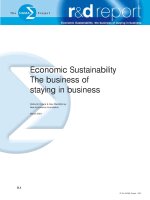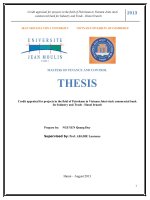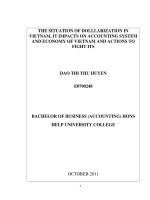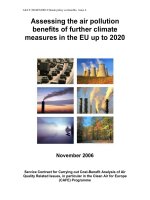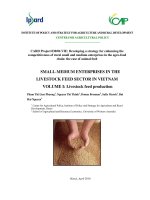Completing the business registration work in vietnam up to 2020
Bạn đang xem bản rút gọn của tài liệu. Xem và tải ngay bản đầy đủ của tài liệu tại đây (15.18 MB, 133 trang )
\ y t ^ ' J ^ i/ui-
\j \~^
UPPSALA UNIVERSITET &
UNIVERSITY OF ECO.NOMICS & BUSINESS, VNIH
U P P SAL A
UNIVERSITET
*****
VNU-UEB
^^.i^j^^jj^Jx^
MASTER THESIS OF MPPM
THESIS
COMPLETING THE BUSINESS REGISTRATION WORK
IN VIET NAM UP TO 2020
Author: Nguyen Thi Viet Anh
Swedish supenisor: Prof. Lars-Torsten Eriksson PhD
Vietnamese supervisor: Dr. Nguyen Thuy .\nh
Class: MPPM - INTAKE 6, Group 24
Hanoi, .May 2013
1
ACKNOWLEDGEMENT
I would like to present my acknowledgement to the dedication of Doctor
NGUYEN, Thuy Anh and Professor - Doctor Lars-Torsten Eriksson to this thesis.
I also would like to sen the most sincere thanks to lecturers of Program MPPM
for valuable knowledge that you have transferred through your lectures, which is
useful for me to complete this thesis.
I would like to thank the International Training Centre of University of
Economics and Business and Uppsala coordinator for guiding me throughout the
learning process as well as to implement thesis project.
I also would like to thank my fellow students for ihcir encouragement by
sharing, and supporting me throughout the learning process, which plays an important
role for the success of this thesis.
Finally, I would like to send sincere thanks to my colleagues for supporting mc
in preparing, collecting data and contribute useful consultation tor this thesis.
ABSTRACT THESIS
THESIS TITLE: Completing the business registration work in Vietnam up to 2020
Author: Nguyen Thi Viet Anh
MPPM Program - Intake 6, Group 24
Level: Final assignment for Master Program in Public Management.
Supervisors:
1. Swedish supervisor: Pro. Lars-Torsten Eriksson
2. Vietnamese supervisor: Dr. Nguyen ThuyAnh
1. Rationale
Business registration procedure is one of the administrative procedures which
have improved dramatically in recent years. The time for market entr> has reduced
from 22 days (in 2005) to 5 days (in 2()07-now). According to Dr. Edmund Malesky.
(Duke University, USA), who leads the investigation about competitiveness index
(PCI) in 2012: "Through the PCI, the biggest improvement o\er time is in business
registration, in order to finish business registration procedure, enterprises usually takes
just seven days on average and onl\- about 2°o of enterprises has to wait more than
three months to finish this procedure". Market entr> index in PCI report 2012
continues to increase and lead 9 groups of component index (8.91 points in 2012
compared with 8.59 points in 2011) (PCI 2012 report).
However, during the implementation, there are still some challenges, problems
existing which must be completed and adjusted, such as issues of macro-economic
policies of state agencies: legal documents are overlapping, unsuitable with the
changes in practice, lacking of good coordination benveen the agencies in enterprise
management. Information about enterprises in the national business registration system
is not accurate and complete: the capacit) of the business registration officers are
limited; aUitude towards people and enterprises are not good; online business
registration is not widely used in the enterprise community
In the past, there were several reports on business registration such as report of
Ms. Leny Van Oyen-UNIDO international expert on business registration reform
situation in Vietnam and support of UNIDO in this sector. The purpose of this report is
to (1) Enhance the national and intemafional vision on business registration reform in
Vietnam (2) Summarizing and sharing latest major achievements in supportina
deployment.
They were developed based on qualitative analysis. Proposed solutions were
drawn from summar>' report, programs, and projects but yet to analvze strengths,
weaknesses, opportunities and challenges of business registration based on quantitative
analysis.
Besides, business registration is a specialized sector under the management
function of Ministr\' of Planning and Investment. I am an official with 10 year working
experience in this sector. I would like to contribute mv research results on challenges,
opportunities of business registration in Vietnam as well as propose solutions,
recommendation for challenges of business registration in Vietnam to be more
integrated with nations in the region and in the world.
2. Research purpose
- Analyze the current situation of business registration
- Evaluate the practical situation of business registration; Find out weaknesses
and their reasons in business registration. Identify strengths, weaknesses, opportunities
and threats of business registration..
- Propose solution for the completion of business registration in the coming time.
3. Research methodology
The author used two main research methodologies: qualitative and quantitative
research methodologies. The SWOT analysis helps find out the current status,
strengths, weaknesses, chances and threats of business registration
The research methodologv is based on primarv data source and secondar} data
to provide general assessment on the situation of the business registration.
4. Conclusion
Following are some conclusions drawn based on the findings of this thesis:
In recenr \ears, business registration sector in X'ietnam has achieved significant
results, however, there still are some national problems need to be solved. On the base
of SWOT analysing, the author has acknowledged that (i) business registration is
facing significant chanllenges but still have opportunities to develop, (ii) comparina
between strength and weakness we can see that the relationship is quite balanced, (iii)
propose 8 solutions to improve business registration until 2020. including S-O. S-T.
W-T, W-0 strategies, (iv) beside these solutions, business registration management
organization can use other ones to reach their targets.
5. Thesis' contribution
5.1. Theoretically
Model SWOT has been applied for private sector to assess operation
effectiveness, however, this is the fisrttime this model is used to analyse the situation
of business registration sector.State organizations in Vietnam should apply model
SWOT when analysing real situation of their operation and then figure out solutions
for their development. Besides, other modern methods like Objective tree. Problem
tree and Performance management svstcm. fish-bone analysing can also be utilized to
increase operation quality of state organizations in Vietnam.
5.2. Practically
This dissertation provides proofs about the weak points, strong points,
opportunities and hazards of the BROs in Vietnam now. which will facilitate -makers
to improving the business registration work. Based on the collected infonnation. the
SWOT matrix is used to identify- the strategic options (S-O. S-T. W-0. W-T) to work
out the policies on the business registration nationwide. This research method work
out solutions with scientific characteristic.This dissertation also helps overcome the
shortcomings that the policies and solutions for perfecting the business registration
work are not based on the real fact.
5.3. There remain some shortcomings in this dissertation.
Firstly, investigated objects are in various groups. One is in private sector, the
other is in state sector. People in priv ate and state may hav e diffirent opinions in terms
of opportunities, challenges, strengths and weaknesses. Secondly, the sumpposition on
opportunities, challenges, strengths and weaknesses is limited because of the lack of
opinions of experienced business registration officials. If possible, there should be
discussions to improv e quality for other research.
Secondly, the foundation assumption about opportunities, threads, strengths and
weaknesses are limited because of the lack of time for collecting opinions from
experienced business registration officials. This shortcomings should be solved in
further research.
Thirdly^ the sample of this research is quite small, i.e. only 190 people, which
also impacts the credibility of the findings. As a result, some outcomes are not as
expected and contradict with the available evidence. Therefore, should carrv' out
another paper, using larger sample is highly recommended. Also, there should be a
comparison between interview results from state-owned and private sectorsso that
solutions can be proposed more appropriately.
Suggestion for the next research orientation: The topic will continue opening
next research orientation: solution to complete organizational structure of business
registration agencies at all level towards an independent svstem from central to
provincial level in order to establish an independent, self-financing
business
registration system and unified in administration in order toensureexpenditures for
effective business registration activities.
6. Key word
Business registration: Business; Business proceduce: The National Business
Registration System; Business registration office: Refonn; Completing the Business
registration work: strengths, weaknesses, opportunities and threats of business
registration.
TABLE OF CONTENT
Page
H
Chapter 1. General Introduction
1.1. Rationale
\\
1.2. Research purpose
12
1.3 Research questions
12
1.4 Research scope
12
Chapter 2. Theoretical model
13
2.1 The model employed
13
2.2 Benefits and Limitation of SWOT analysis
15
Chapter 3. Research methodology
17
3.1. Research procedure
17
3.2. Data sources
Ig
3.2.1 Identify and listing data
18
3.2.2. Data collection
18
3.2.3. Gather infonnation by questionaire
21
3.4. Data analysis
21
Chapter 4. Business registration over\iew
22
4.1 Concepts
^2
4.1.1 Administrative procedure
22
4.1.2 Business registration
22
4.1.3 National Business Registration System
23
4.1.4 Business environment
23
4.2 Business registration tasks
^^
4.2.1 Business registration tasks
-"^
4.2.2 Reform procedure of business registration
24
4.2.3 Achievements
-'
4.3 Application of SWOT analysis for business registration w ork
30
Chapter 5. Data analysis
^^
5.1. Data collection
34
5.2 Analysis of collected data
^^
7
5.2.1 Opportunities
36
5.2.2 Threats
39
5.2.3 Strengths
41
5.2.4 Weakneses
44
Chapter 6. Solutions to complete the policies of business registration up to the year
of 2020
49
6.1. SO Strategy
51
6.2. WO strategy
52
6.3 ST Strategy
53
6.4. WT strategy
53
Chapter 7. Reflection and Conclusion
54
7.1. Conclusion
54
7.2. Thesis' contribution
54
7.2.1. Theoretically
54
7.2.2. Practically
54
7.3. Shortcomings and future research orientation
54
List of references
Appendix 1: Questionnaire sur\ey
55
58
Appendix 2: Inter\iew question
63
8
LIST OF FIGURES
FIGURE2.1: NUMBER OF NEW REGISTRATION ENTERPRISES IN
FIGURE2.2:STRUCTURE OF SURVEY RESPONDENTS ACCORDING TO THEIR
POSITIONS
FIGURE 4.1: GENDER STRUCTURE OF SURVEY RESPONDENTS
FIGURE 4.2: STRUCTURE OF WORKING AREAS OF SURVEY RESPONDENTS
FIGURE 4.3: WORKING TENURE OF SURVEY RESPONDENTS
FIGURE 4.4: ANSWER RATE OF OPPORTUNITIES
FIGURE 4.5: RESULT OF THREATS
FIGURE 4.6.1: ANSWER RATE OF STRENGTHS
FIGURE 4.6.2:ANSWER RATE OF WEAKNESSES
FIGURE 4.7: ORGANIZATION STRUCTURE OF ABR
FIGURE 5.1: WORKING POSITION
FIGURE 5.2: GENDER
FIGURE 5.3: WORKING AREA
FIGURE 5.4: YEAR OF WORKING EXPERIENCE
FIGURE 5.5: PROPORTION OF ANSWERED OPPORTUNITIES
FIGURE 5.6: PROPORTION OF ANSWERED HAR2ARDS
FIGURE 5.7: PROPORTION OF ANSWERED STRENGTHS
FIGURE 5.8: PROPORTION OF ANSWERED WEAKNESSES
ABBREVIATION
NBRS: National Business Registration Svstem
BR: Business registration
BRO: Business registration office
MPI: Ministrv' of Planning and Investment
ABR: Agency for Business Registration
DPI: Department of Planning and Investment
UNIDO: United Nations Industrial Development Organization
NORAD: Nonvegian Agency for Development of Cooperation
SECO: Swiss State Secretariat for Economic Affairs
VCCI: Vietnam's Chamber of Commerce and Industrv'
GDT: General Department of Taxation
GSO: General Statistics Office
MPS: Ministrv' of Public Security
CIEM: Central Institute for Economic Management
HCMc:HoChiMinhCity
OSS: One stop shop
WTO: World Trade Organization
WB: World Bank
10
CHAPTER 1: GENERAL INTRODUCTION
1.1. Rationale
The world is witnessing the trend of strong globalization and trade
liberalization: thereby, a change and integration is taking place in everv countrv. Being
along with the alteration of the world's economy. Vietnam has harvested some
achievements in social - economic development, especially in terms of growth speed
and social welfare practice. When accounting the contributions to this achievement.
we cannot deny the great dedication of administration reform. According to the
Deputy Prime Minister Nguyen XuanPhuc: ^The Government of Vietnam has always
placed a top priority for administrative reform, in order to build an effective public
administration, which considers people and enterprises as centre, as well as performs
international commitments on transparencv. enhancing the access to infonnation on
government regulations by people and enterprise." (www.thutuchanhchinh.vn).
Business registration procedure is one of the administrative procedures which
have improved dramatically in recent vears. The time for market enirv has reduced
from 22 days (in 2005) to 5 days (in 2007-novv). According to Dr. Edmund Maleskv.
(Duke University, USA), who leads the investigation about competitiveness index
(PCI) in 2012: "Through the PCI. the biggest improvement over time is in business
registration, in order to finish business registration procedure, enterprises usuallv takes
just seven days on average and only about 2% of enterprises has to wait more than
three months to finish this procedure". Market entrv index in PCI repon 2012
continues to increase and lead 9 groups of component index (8.91 points in 2012
compared with 8.59 points in 2011) (PCI 2012 report).
However, during the implementation, there are still some challenges, problems
existing which must be completed and adjusted, such as issues of macro-economic
policies of state agencies: legal documents are overlapping, unsuitable with the
changes in practice, lacking of good coordination between the agencies in enterprise
management. Infonnation about enterprises in the national business registration system
is not accurate and complete: the capacity of the business registration officers are
limited: attitude towards
11
people and enterprises are not good: online business registration is not widely used in
the enterprise community
In the past, there were several reports on business registration such as report of
Ms. Leny Van Oyen-UNIDO. international expert on business registration refonn
situation in Vietnam and support of UNIDO in this sector. The purpose of this report is
to (1) Enhance the national and international vision on business registration reform in
Vietnam (2) Summarizing and sharing latest major achievements in supporting
deployment.
They were developed based on qualitative analysis. Proposed solutions were
drawn from summar>' report, programs, and projects but yet to analyze qualitatively
strengths, weaknesses, opportunities and challenges of business registration based on
the use of SWOT model..
Besides, business registration is a specialized sector under the management
function of Ministr>' of Planning and Investment. 1 am an official with 10 year working
experience in this sector, I would like to contribute my research results on challenges,
opportunities of business registration in Vietnam as well as propose solutions,
recommendation for challenges of business registration in Vietnam to be more
integrated with nations in the region and in the world.
1.2. Research purpose
- Analyze the current situation of business registration
- Evaluate the practical situation of business registration: Find out weaknesses
and their reasons in business registration. Identifv' strengths, w eaknesses. opportunities
and threats of business registration.
- Propose solutions for the completion of business registration in tlie coming time.
1.3 Research questions
I hereby, research questions of the thesis are:
I .What is the current situation of business registration? What are the
achievements and outstanding issues?
2. What can the (iovernment. Ministrv of Planning and Investment and related
agencies do to complete business registration procedure in upcoming time?
1.4 Research scope
This topic is to propose policv solutions for business registration from now to
2020. Because each policy has its implementation period, state agencies will evaluate
implementation results and continue to develop policies for next period. Therefore,
research result of the topic is to complete business registration policies to 2020.
12
CHAPTER2. REFERENCE FRAME
2.1 The model employed
Figure 2.1: SWOT model (source: http:/ timnguvenmarketing.com)
Based on the aggregation of ^\AVAv.wikipedia.org. vvww.n-
'MenlucK.com, the
evaluation on Strengths and Weaknesses or called internal evaluation in the aspect of
awareness, reputation, fame, finance, technology, relationships, culture of the organization...
This evaluation only has relative properties in comparison with the general ground.
Evaluation on Opportunities and Threat or called external analysis because
those factors have relation with external environment. Factors related to threats and
opportunities may come from tluctuations of the economy (growth or decline),
changes of State policies (favourable or unfavourable for the operation of enterprise,
organization) changes of competitive balance (appear or disappear of a competitor)...
From SWOT analysis, SWOT matrix can be formed in order to draw out strategic
solutions.
SWOT analysis is the subjective evaluation of data arranged by SWOT format
according to a logical order which is easy to understand, present, discuss and decide,
and can be used for all decision procedure. SWOT templates encourage thinking rather
than basing on habitual or instinctive reactions. SWOT analysis templates are
presented by a two column and two row matrix, divided into 4 parts: Strengths,
Weaknesses, Opportunities and Threats (source: '
13
Miiarkctinu.com)
Opportunities
O
Threats
o,
T,
03
Figure 2.2: SWOT Matrix Diagram
In which
Sa
strengths, proposed that there are g strengths
Wa
weaknesses, proposed that there are h weaknesses
Ob
opportunities, proposed that there are x opportunities
Tb
threats, proposed that there are y threats
Factors of SWOT matrix can suggest strategic solutions to promote
opportunities in order to make use of opportunities by researching, analyzing SaOb;
prevent threats by researching, analyzing SaTb; understand weaknesses to mitigate
them by analyzing WaOb and creating dilTiculties in being against threats by
WaTbanalysis.
SWOT model otkn gives 4 basic strategies
14
(source: hUp://timnguvenmarketino.com):
(i) Strategy S-0(Strengths
- Opportunitiesjis the strategv that using the
internal strengths of the organization to take advantage of external opportunities..
(ii) Strategy W-0{Weaknesses - Opportunities)^
the strategv that improves
internal weaknesses by taking advantage of external opportunities. Sometimes, big
external opportunities are existing but the organization has internal weaknesses that
prevent the organization from making use of those opportunities..
(iii) Strategy S-T (Strengths -
Threats) is the strategv that uses the
organization's strengths to avoid or minimise the impact of external threats. This
strategy does not mean that a strongorganization alwavs copes with external threats.
(vi) Strategy W-T (Weaknesses - Threats) is the defence strategies to mitigate
internal weaknesses and avoid external threat. An organization coping with many
external threats and internal weaknesses may make it fall into unsafe situation.
Effective strategies are strategies using external opportunities and internal
strengths as well as disabling external threats and limiting or overcoming v\eaknesses
of the organization.
2.2 Benefits and Limitation of SWOT analysis
Benefits of SWOT analysis
(Extracted from http://wv\AV.business.qld.gov.au)
The main advantages of conducting a SWOT analvsis is that it has little or no
cost -If managemant who understands Organization
then
can perform a S\\'OT
analysis. And can also use a SWOT analysis when Organization doesn't have much
time to address a complex situation. This means that managemantcan take steps
towards improving your business without the expense of an external consultant or
business adv iser
Another advantage of a SWOT analysis is that it concentrates on the most
important factors affecting Organization. I'sing a SWOT Organizationcan:
UnderstandOrganization better
Address weaknesses
Deter threats
Capitalise on opportunities
15
Take advantage of strengths
Develop business goals and strategies for achieving them.
Limitations of SWOT analysis
(Extracted from )
When Organization are conducting a SWOT analysis, should keep in mind that
it is only one stage of the business planning process. For complex issues, will usually
need to conduct more in-depth research and analvsis to make decisions.
Keep in mind that a SWOT analysis only covers issues that can definitely be
considered a strength, weakness, opportunity or threat. Because of this, it's difficult to
address uncertain or two-sided factors, such as factors that could either be a strength or
a weakness or both, with a SWOT analysis (e.g. might have a prominent location, but
the lease may be expensive).
A SWOT analysis may be limited because it:
Doesn't prioritise issues
Doesn't provide solutions or offer alternative decisions
Can generate too many ideas but not help choose which one is best
Can produce a lot of infonnation. but not all of it is useful.
16
CHAPTER 3. RESEARCH METHODOLOGY
The author used two main research methodologies: qualitative and quantitative
research methodologies
3.1 Research procedure
io
Details
fheoretical
rame
- Collection of SWOT documents
Study documents
- Collection of documents on issue, References,
magazines,
target tree diagrams
internet
nformation of
)usiness
egistration works
Collection of summary reports,
working plans of ABR- MPI
Secondar>
source
Collection of presentations, reports,
researches of international and
national experts and managers on
business registration
Secondary
source
Enterprise surveys
Primary source
Surveys of ABR-MIP's officials
Primary source
Collection,
description,
imalysis,
comparison to
evaluate the
practical situation
of business
registration works
Sources
Deputy Minister of Ministry of Planning and Investment
Deputy Director General of Agency for Business
Registration
Deputy Director of Legal Department
Deputy Chief of Central Institute for Economic
Management (CIEM)
Deputy Director General of General Department of
Taxation - Ministry of Finance
Acting Director of Legal Department of Vietnam
Chamber of Commerce and Industry (VCCI)
- Analyze practical situation of business registration
works
- Analyze policies
- Analyze Leaders' orientations
- Analyze SWOT^s factors
17
Method/tool
Via emai
Via emailDirect
Direct
Via phone
-Microsoft
Excel
-MSPPS
software vs.
11.5
. AutoCAD
software
3.2. Data sources
3.2.1 Identify and listing data
In order to identify information which need collecting, first of all SWOT
theoretical SWOT analysis, issue, target tree diagrams should be stronglv understood"
thereby, collecting theoretical frame, information on business registration works in
Vietnam
3.2.2 Data collection
Secondary data source:
- Conclusion reports, data reports, business plan on business registration of
Ministry of Planning and Investment (Agency of Business Registration):
- Articles, speeches, research reports of local and foreign experts and business
registration experts.
Primary data source:
Prepare questions to interv^iew several Leaders working in Ministrv of Planning
and Investment. Ministrv' of Finance and VCCI. Interview methods: directly, via
phone. Use questionnaire to interview 140 local staffs and government officials
working on business registration and 50 national enterprises.
Questionaire:
Prepare questionaire for officals of the Agencv of Business Registration and
staffs of business registration offices. The questionaire is sent to targeted receivers and
submited via email.
20 officials of the Agency of Business Registration. 120 staffs of business
registration offices - Planing and Investment Department of provinces^cities: Ho Chi
Minh city (60 staffs). Da nang (15 staffs). Ca mau (3 statTs). Vung tau (5 staffs). Dong
thap (5 staffs). Thai nguyen (5 staffs). The total number of interviewed people is 140.
About enterprises
50 enterprises in 3 representative provinces for 3 regions of Vietnam: the North.
the Middle, and the South are: Quang Ninh. Da Nang. Ho Chi Minh City.
Gather investigation data, questionaire...
18
Gather information by questionaire. at the same fime. carrv- out in-depth
interviews. After processing information, opportunites. threats, strengths and
weaknesses will be analyzed in order to figure out solutions to prevent weaknesses,
inspire strengths, take oppotunities in to advantage and solve the threats.
Interviewed objectives are devided into two groups, including people working
for state areas and for enterprises. One builds and implements law. the other one
executes law; however, they have one thing in common which is the relevant to
administrative procedure of enterprise. On the other hand, nowadays, enterprise's
understanding about law is higher. Enterprises not only execute law but also superv ise
and make contribution to law system establishment and operation of state agenciess.
Ministry of Planing and Investment has held a number of conferences with attendance
of enterprises to amend Enterprise Law. Investment Law...
Qualitative method
Qualitative method is usually used to estimate regular business registration
operation results of Ministry of Planing and Investment (Agency of Business
Registration). This method is also used by several experts to build business registration
operation plan.
Further more, being a 10-year-experienced business registration officials. I have
the foundation to ev aluate the current situation of this area. This thesis is also the
accumulated note during my working time in order to reflect the current situation of
business registration area..
This qualitative analysing method is applied together with analvsing method SWOT.
In-depth inter\iew method
Target: on the basic of opinions of experts to work out acknoledgment and
solutions in order to complete the research.
Quantity: 6 people
Objectives: Leaders of Ministry of Planing and Invesment. Ministry of Finance,
several departments, agencies, and organizations related to business registration.
Interview content: build questionaire for experts:
+ Whv need to complete business registration?
+ Strengtlis. weaknesses, opportunities, challenges of business registration area?
+ Solutions to complete legal frame for business registration untill 2020?
19
+ Resources to complete legal frame for business registration?
Implementation: ask for experts" timetable then interview directly or via
phones on April 25-26. 2014. Gather results on April 28. 2013
Quantitative analysing method
Questionaire
Target: the quesfionaire sets target for the interv iew and investigate opinions
about business registration of different people with different experience, different
areas.
Number of questionaire: 190
Objective: 20 officials of Agency of Business Registration and 120 staffs of 10
business registration offices. 50 enterprises in 3 provinces'cities.
Questionaire content: the questionaire includes 53 questions, including:
- General infonnation about investigated objectives
- General infonnation about investigation content: questions concentrate on
finding the answer for sthengths, weaknesses, oppotunities and challenges of business
registration area.
Implementation:
- Sending questionaire: April 25, 2013
- Gathering questionaire: April 27. 2013
- Gathering data: April 29, 2013
Data showing method
- Data table
Oppotunities. challenges, strength and weakness of state organizations are built
by gathering, analysing, estimating and choosing on the base of opinions and
ackowledgement mentioned in referent reports, articles, pulished interviews, annual
reports and operating direction of provincial Leaders. Base on experience from a
number of vears working in this area, the author propose some oppotunities.
challenges, strengths and weaknesses that have not been mentioned before. Then.
detailed contents strengths, weaknesses, threats and opportunities are collected,
analysed, e\ aluated and suggested.
20
3.2.3. Gather information by questionaire
Questionaire is prepared and sent directly to officials of the Agency of Business
registration, and sent to emails of 10 business registration officers. For enterprises,
questionaire will be sent to business registration offices and the staffs will sent to
enterprises. Everday enterprises have to go to business registration offices to complete
administrative procedures so it is very convenient for the investigation. Each day,
business registration office of Ho Chi Minh city deals with about 600 enterprises. Da
Nang deals with about 200 enterprises. Quang Ninh deals with about 50 enterprises.
The number of enterprise are different because of the discrepancies in growth speed of
the locations.
The purpose of the questionnaire is to verify the opportunities, threats, strengths
and weaknesses. Respondents gave their views on whether these components were
correct or not. Some studies use Likert scale, i.e. having five levels with T* level is
totally incorrect and 5^ level are totallv correct. In this research, the respondents hav e
three options: "Agree" with the statement. "Disagree" and "Don't know". This format
is simpler than the Likert scale which might be difficult to the respondents. The option
'^Don't know" was provided in case the respondent did not have sufficient
understanding about the issues.
3.4. Data analysis
Author wanted to select the core issues to confinn that they are SWOT factors
and then recommend the most concentrated strategies avoiding resources for
implementation. Therefore, only questions with more than 60% of "agree" answer are
confinned to be SWOT factors. Any questions with more than 20% of "don't know"
answer will be rejected. Any answers which is 10%< not agree<20% and "don't
know" answer <20% will be rejected.
The factors which are confinned to be correct will be used in SWOT matrix
(figure 2.2) to develop strategic recommendations.
Based on data collected from questionnaires and interview will be analysedto
find out opinions, comparisons, reference and will be the basis for explanation of
results and findings.
Percentage of the different answers of the respondents is calculated bv SPSS
software.
21
CHAPTER 4. BUSINESS REGISTRATION WORK OVERVIEW
4.1 Concepts
4.1.1 Administrative procedure
Administrative procedure is the order, implementation method, dossier and
requirements, conditions regulated by state agencies, authorities to process a specific
task relating to an individual, organization.
For example: Procedure for the issuance of Business registration certificate for
a limited liability company with two members
->isan administrative procedure
Purpose: To certify the birth and existence of an economic legal person on the
market: thereby, state agencies can have infonnation to manage enterprise.
Issuance procedure:
- Step 1: Applicant prepares 01 dossier
- Step 2: Submit at Business registration agency
- Step 3: Come to get the result after 5 days after the date of submission
Dossier: (1) Letter of request: (2) Copy of personal identification paper of legal
representative; (3) Company charter; (4) List of capital contribution of members.
Issuance conditions:
- Dossier is fullv submitted
- Having contact address of applicant
- Fees are fullv paid
Submit at: prov incial business registration olTice
4.1.2 Business registration
Business registration includes business registration and tax registration for
enterprises registered under Enterprise Law.
Pursuant to the regulations of Enterprise I aw 2005. registration for issuance
business registration certificate is the first procedure to do business as an enterprise. In
order to establish one of the four enterprise ivpe including LCC. shareholding
company, private enterprise or partnership enterprise, applicant must perform the
22
procedure of issuance of Business registration certificate at provincial business
registration office where enterprise's head office is located.
4.1.3 National Business Registration System
Notional business registration system is a specialized system on business
registration chaired by Ministry of Planning and Investment, cooperating with related
agencies to build and operate in order to send, receive, store, display or perform other
process for data of business registration. Nafional business registration includes
National business registration portal and National business registration database.
4.1.4 Business environment
Business environment is all factors affecting activities of an enterprise. It
includes:
Internal environment
enterprise...
includes: culture, vision, missions, and goals of
External environment: laws, policies, customers, competitors, partners...
Business environment reform is the action of state management agencies to
adjust, amend legal regulations on sectors in order to ensure the smooth, transparency,
simple, ease of application of policies for enterprises in the economy.
Figure LI: Model of central and provincial
business registration agencies
23
4.2 Business registration tasks
4.2.1 Business registration tasks
Tasks of business registration agencies are:
- Central level:
Ministry of Planning and Investment (Agency for Business Registration) is the
agency assigned to perform the state management on business registration, having the
following responsibilities:
Making policies, legal provisions on dossier, order, procedure on business
registration.
Establishing National business registration system
Cooperating with Ministr>' of Finance. General Statistics Office. Ministrv of
Public Security and other relating agencies in the connection, enterprise infonnation sharing.
- Provincial level
Provincial people 's committee (Department of Planning and Investment-DPIi is
the state management agency on business registration at local level with the following
responsibilities:
Issuing Business registration certificate
Updating enterprise data on national business registration system
Cooperating with Department of Finance. Department of Public Security and
other agencies in the connection and enterprise infonnation sharing.
Inspecting the business condition compliance of enterprises.
4.2.2 Reform procedure of business registration
TTierc are four main periods of business registration:
Period I (1986-1990): This is the first time when economic development in
individual, private sector were promoted in the central planning economv with the
premise decrees for the regulations of business registration regime.
Period II (1991-1999):Change from "pre-check'^ to "post-check"
By simplifv ing the procedures for setting up businesses, abolishing hundreds of
inappropriate licenses and regulations on business conditions and establishing a new
legal document system guiding implementation of the Enterprise Law 1999 and the
24
implementation of this Law has contributed significantly to the establishment of a
legal framework for equality and non-discrimination for all types of enterprises,
transition of state management mode for business from "pre-check "to" post-check",
transition of business registration mode from " approval and allocation" to mainly
serving, supporting and guidancing.
Since strong reforms on business establishment procedures of the Enterprise
Law 1999, the number of registered enterprises nation-wide has significantly
increased, in this period there were approximately 45,000 enterprises bom.
Period III (2000- 2007): "Connection" of three procedures
Before 2006, enterprises had to step by step performed procedures for business
registration, tax registration and seal engraving at three different agencies with
duplicated papers, procedures. The minimum time to complete all three procedures
were 32 days as prescribed by law.
Coordination of three agencies reduces time for processing a dossier. The
introduction of "one stop shop" mechanism for business registration has created a legal
basis for provinces to implement at the same time professional tasks of three agencies:
business registration, tax registration and seal registration; thereby eliminating
unnecessary procedures, shortening the processing time of three procedures from 32
days to 15 days
Figure 4.2.1: Cooperation model between Ministry of Planning and Investment
and General Statistics Office, Ministry of Finance/General Department of
Taxation and Ministry of Public Security
Period IV (2007-now): "Consolidation of market entry procedures"
25
